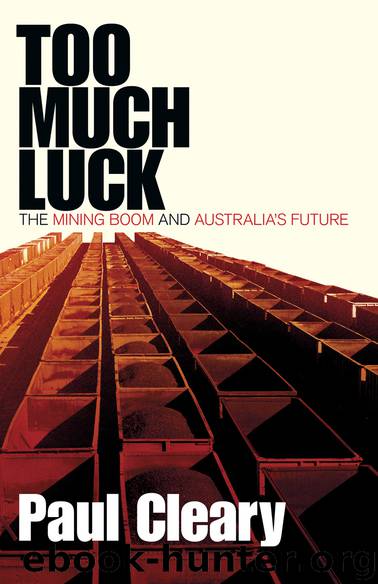Too Much Luck by Paul Cleary

Author:Paul Cleary
Language: eng
Format: epub
Tags: Too Muck Luck, The Mining Boom and Australia’s Future, Paul Cleary
Publisher: Schwartz Publishing Pty. Ltd
Published: 2011-07-21T04:00:00+00:00
A Taxing Invention
The super-tax episode is not an isolated case. Australia has a long history of failing to exercise strong governance over mineral and energy resources. For over 150 years this country has celebrated those who are able to hold government to ransom and refuse to pay for the right to exploit our wealth, starting with the miners at the Eureka Stockade, who revolted over a plan to impose higher taxes. In the latest episode, billionaire miners stood shoulder to shoulder with workers in hard hats, as though they had a common interest.
One of the legacies of Australia’s 1901 Constitution is that state and territory governments control the development of mineral concessions. These governments have proved particularly inept at taxing the industry. They say you should never stand between a state premier and a bucket of money, but when it comes to mining, it’s a special case. Taxes and royalties haven’t kept up with the huge profits now being earned. For example, when revenue earned by mining companies increased three-fold over the course of the last decade, the royalties paid to state governments increased only 2.3 times.
It is no exaggeration to say that every state government in Australia has been letting down its citizens, especially since the 1970s, when a better way to tax mining emerged. From 1973, Australian economists Ross Garnaut and Anthony Clunies-Ross set out in economic literature how a resource rent tax (RRT) would capture a fair share of profits without undermining investment in the industry. In using the term ‘rent’, they were targeting the very high profits that accrue when companies are given control of a valuable commodity of which there is finite supply. The two had been working in Papua New Guinea, where the Bougainville mine had been given extended tax exemptions by the colonial administration. As Garnaut explained, this mine, which began production in 1972, soon benefited from very high copper and gold prices. The site was so profitable that half of Rio’s profits came from this single mine, although the company only owned half of it. ‘They’d been given a tax-free holiday, been able to hold depreciation, and then gold was going to be tax-free. It was an extraordinary agreement,’ he says.80
The two men set their minds to devising a way of collecting a fair share of Bougainville’s profits without discouraging investment in other mines. They came up with the RRT, a tax that only kicked in when returns exceeded the threshold needed to justify the investment in the first place (they put this at 10 percentage points above the long-term risk-free bond rate). The art of taxation has been described as plucking the goose in such a way as to maximise the quantity of feathers obtained and minimise the hissing. Garnaut and Clunies-Ross had devised a no-hiss tax, or so they thought. The federal Labor Party adopted the principle of the RRT as part of its platform, although the state branches were evidently not paying attention. Not long after winning office in
Download
This site does not store any files on its server. We only index and link to content provided by other sites. Please contact the content providers to delete copyright contents if any and email us, we'll remove relevant links or contents immediately.
The Meaning of the Library by unknow(2382)
Six Billion Shoppers by Porter Erisman(2223)
Why Nations Fail: The Origins of Power, Prosperity, and Poverty by Daron Acemoglu & James Robinson(2161)
No Time to Say Goodbye(1993)
Red Notice by Bill Browder(1923)
The Economist [T6, 22 Thg9 2017] by The Economist(1843)
Currency Trading For Dummies by Brian Dolan(1785)
Thank You for Being Late by Thomas L. Friedman(1675)
Bitcoin: The Ultimate Guide to the World of Bitcoin, Bitcoin Mining, Bitcoin Investing, Blockchain Technology, Cryptocurrency (2nd Edition) by Ikuya Takashima(1609)
Amazon FBA: Amazon FBA Blackbook: Everything You Need To Know to Start Your Amazon Business Empire (Amazon Empire, FBA Mastery) by John Fisher(1490)
Coffee: From Bean to Barista by Robert W. Thurston(1417)
The Future Is Asian by Parag Khanna(1396)
The Great Economists by Linda Yueh(1386)
Capitalism Without Capital: The Rise of the Intangible Economy by Jonathan Haskel(1336)
Pocket World in Figures 2018 by The Economist(1325)
How Money Got Free: Bitcoin and the Fight for the Future of Finance by Brian Patrick Eha(1320)
Grave New World by Stephen D. King(1312)
The Sex Business by Economist(1278)
Cultural Intelligence by David C. Thomas(1200)
